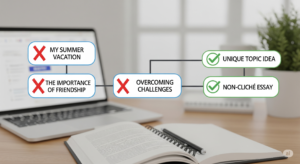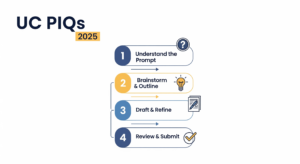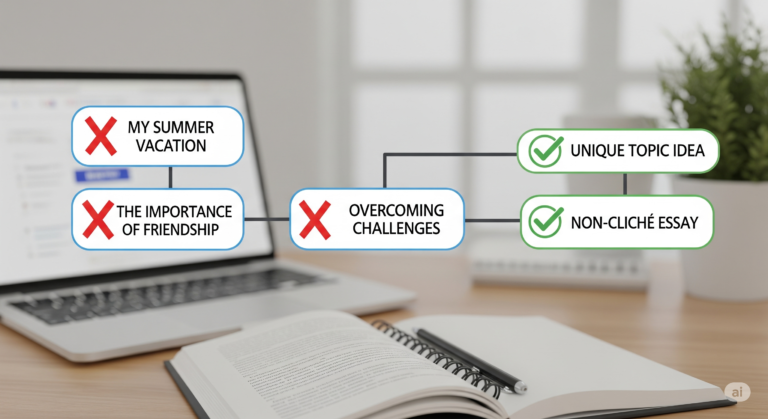The UC Personal Insight Questions aren’t mini personal statements. They’re four short windows into how you think, what you do, and what you’ve learned. Readers skim fast. Specifics win.
What UC readers tend to value
- Clarity over drama. A clean arc > a grand story.
- Specificity. Concrete details, numbers, names of tools/roles/contexts.
- Agency. What you did (verbs!) vs. what happened to you.
- Growth. A small, durable shift in thinking or behavior.
- Fit to the prompt. Answer the question directly, early, and consistently.
Quick sanity check: Could a classmate swap their nouns into your essay and it still “work”? If yes, it’s too generic.
The 350-word discipline (trim without losing soul)
- Open in-scene within 1–2 sentences.
- 1. Use first person, active voice, short paragraphs (1–3 lines).
- 2. Keep one storyline per PIQ.
- 3. Include: 3 specifics, 2 numbers, 1 mini “so-what.”
- Cut: throat-clearing (“I have always…”), repeat resume lines, vague adjectives (passionate, dedicated, unique).
Choose your four (smartly)
Aim for range across your four PIQs: one leadership/impact, one academic/curiosity, one creativity/identity, and one challenge or community. Avoid repeating the same activity from the same angle.
3 Plug-and-Play Mini Outlines
A) Leadership (with or without a title)
– Prompt fit: “Describe an example of your leadership experience…”
- – Hook (1–2 sentences): Drop into a moment of tension (a missed deadline, a conflict, a bottleneck).
- – Role & objective (1–2 sentences): Your position (formal or informal) and what needed changing.
- – Actions (120–170 words): 2–3 concrete steps you took. Include tools, metrics, iterations (e.g., “created a color-coded Kanban; late tasks fell from 11→3”).
- – Result (2–3 sentences): Outcome with numbers or observable change.
- – Reflection (3–4 sentences): One lesson you still use (e.g., how you run meetings, how you listen).
– Avoid: Listing titles; saving the day alone.
– Micro-detail ideas: meeting agenda you invented, template you built, training you ran, handoff doc, conflict script.
B) Academic Interest / Intellectual Curiosity
– Prompt fit: “Describe how you have taken advantage of a significant educational opportunity or worked to overcome an educational barrier.” (Also supports the “academic subject” angle.)
- – Spark (1–2 sentences): The question/problem that hooked you.
- – Constraint (1–2 sentences): What made it hard (no course offered, limited materials, schedule).
- – Pursuit (120–170 words): What you tried: readings, projects, labs, forums, outreach to mentors, competitions—show sequence and adjustments.
- – Artifact (1–2 sentences): The thing you produced (poster, dataset, app, zine) and one result.
- – Carry-forward (3–4 sentences): How this shapes current study habits, club roles, or future exploration (no grandiose forecasts).
– Avoid: Broad “love of X” statements without a traceable trail.
– Micro-detail ideas: specific paper/author, tool/library, dataset, outreach email, micro-experiment.
C) Creativity / Problem-Solving
– Prompt fit: “What would you say is your greatest talent or skill? How have you developed and demonstrated that talent over time?”
- – Snapshot (1–2 sentences): A small creative decision point (arranging a piece, redesigning a layout, devising a workaround).
- – Method (2–3 sentences): Your creative process (constraints you set, feedback loop, versioning).
- – Demonstration (120–170 words): One project from problem → iteration → result. Include failure/misstep and what you changed.
- – Impact (2–3 sentences): Whom did it help? What shifted?
- – Transfer (3–4 sentences): Where else you apply this skill (teamwork, labs, community).
– Avoid: Vague “I’m creative” claims.
– Micro-detail ideas: version numbers, rubric you wrote, color code, rehearsal log, code snippet behavior.
Polishing checklist (use before you submit)
- Prompt is answered by line 3.
- At least three specifics (names, tools, numbers, proper nouns).
- One visible change (behavior, system, outcome).
- No resume dump. Activities section lives elsewhere.
- Voice test: Read aloud. Do you sound 16–18, not a grant proposal?
- Trim test: Delete the first sentence; did anything essential vanish? If not, keep it deleted.
Common pitfalls (and fast fixes)
- Too many threads: Pick one and go deeper.
- Big claims, no receipts: Add a metric, artifact, or stakeholder quote.
- Reusing the same story angle across PIQs: Rotate lenses—impact, curiosity, identity, resilience.
- Future-casting only: Anchor in what you already did.
Sample micro-openings (steal the structure, not the words)
- “By week three, the spreadsheet had 97 rows and zero decisions. I rebuilt it into a one-page Kanban; late tasks dropped from 11 to 3.” (Leadership)
- “Our school didn’t offer linear algebra, so I borrowed Strang’s book from the community college and built Python notebooks to model Markov chains.” (Academic)
- “The layout kept burying student art. I rewired the zine’s grid, cut word count by 18%, and submissions rose by a third.” (Creativity)
FAQ
Can I write about leadership without a title?
Should I tie PIQs to my intended major?
Can I reuse parts between PIQs?
Final step
Map your four PIQs on a sticky note:
L (influence) • A (curiosity) • C (creativity/skill) • R (resilience/community).
If two stickies tell the same story, swap one out.










